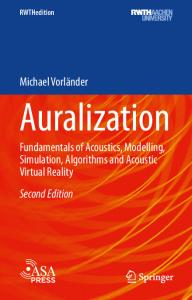Virtual Reality
- PDF / 54,820 Bytes
- 3 Pages / 504.567 x 720 pts Page_size
- 40 Downloads / 330 Views
Virtual Reality Roy Damgrave Department of Design, Production and Management, University of Twente, Enschede, The Netherlands
Synonyms Virtual environments
Definition Virtual reality (VR) is an artificial reproduction of a potential reality or use condition that enables users to experience and/or modify and/or to interact with. These computer-simulated environments are experienced mainly through the senses of sight and sound. VR systems have the following key properties (Burdea and Coiffet 1994): • 3D-representation and perception • Spatial interaction in real-time • Sense of presence and immersion
Theory and Application Virtual reality is the linkage between reality, behavior (partly real, partly simulated), and
artifacts. VR handles the real-time integration between computer-simulated environments and human interaction (Cobb and Sharkey 2007). A VR environment stimulates the users to experience an envisaged reality or use condition by stimulating the right senses at the right moment, to generate the right perception of the situation. The envisaged reality is not a completely predefined setting, but allows the user (or creator of the environment) to modify it along time. The main difference between a rendered static movie and a VR environment is the possibility for the user to interact with the system, the system will respond to the given information and two, or more, objects have effect upon each other. The notion “virtual reality” depicts all kinds of products and services that support or enrich the real world through enhancing it with virtual presentation or interaction with information. Virtual reality therefore ranges from simple displays to fullblown 3D environments using holograms and all related ways to interact with them. The envisaged reality in the simulated environment can be a best possible copy of the real world, for use in simulation or training, or it can differ significantly from the real environment (when the link with the real world is unwanted). According to Burdea (Burdea and Coiffet 2003), VR applications can be characterized with the “3 I’s of Virtual Reality”: immersion, interaction, and imagination. Immersion to let the user feel to be a part of the actions taking place in the virtual environment, interaction for
# CIRP 2016 The International Academy for Production Engineering et al. (eds.), CIRP Encyclopedia of Production Engineering, DOI 10.1007/978-3-642-35950-7_6472-4
2
the response of the VR environment to the given user input, and imagination refers to the human capacity to perceive nonexistent objects. Blach (Blach 2008) uses the following aspects to classify and characterize VR solutions: • Interaction modalities: Humans are capable of sending and receiving signals to the VR system using the five senses, the VR application provides stimulants for one or more of these modalities. • Spatiality: The interaction and representation of the VR system can have various levels of spatiality; this combines 1D, 2D, and 3D input and output. • Degree of embedding the physical reality: Intera
Data Loading...











